The Trash of the Future
Looking at the various ways Walt Disney World handles food service waste
Welcome to another edition of Willoughby Hills!
This newsletter explores topics like history, culture, work, urbanism, transportation, travel, agriculture, self-sufficiency, and more.
If you like what you’re reading, you can sign up for a free subscription to have this newsletter delivered to your inbox every Wednesday and Sunday and get my latest podcast episodes:
A few years ago, I wrote a newsletter reacting to an editorial published by the Orlando Sentinel that was pushing Disney to immediately abandon selling meat in favor of new meat imitators like Impossible Burger. I was not in favor of the substance of the debate as these imitation meats often come with their own environmental and nutritional challenges, but I also called upon Disney to improve their dining options to include things like grass fed and pastured meats. As I stated at the time:
“Disney has always been a laboratory for new ideas that vacationers can then take back to their hometowns.
Imagine the impact of forgoing factory farmed beef and instead opting for pasture-raised at a single Disney park like Animal Kingdom! Millions of people per year would be exposed to this idea, and maybe learn a little more about this issue, which is clearly very complex. It may even lead to behavior changes once some of those guests return home.”
After spending a significant bit of time at Walt Disney World this month, I still feel strongly that Disney can help shape public perceptions and attitudes and may even train new habits in visitors. At the moment, Disney seems to have differing approaches to how they handle food packaging and waste, some which is cutting edge, some which is lagging behind.
The entire resort area encompasses four theme parks, more than two dozen hotels, and land that’s twice the size of Manhattan. It truly is its own city, but it feels like it’s lacking a master plan or consistency in how waste is approached and handled. I wanted to share some of my observations and thoughts on the different approaches.
Disney likes to talk the talk when it comes to sustainability. They have an entire webpage devoted to their sustainability goals. Here’s how they describe their approach to waste:
“Since 2009, Disney has operated under a long-term vision to achieve zero waste in our operations. We have made significant progress toward this goal including through a series of waste management initiatives to reduce, reuse, recycle, donate, and encourage behavior change initiatives with our guests and employees, in order to divert as much material as possible from landfills.
While we are proud of the progress we have made, we are committed to doing more. We will work to achieve zero waste to landfill for our wholly owned and operated parks, resorts, and cruise line by 2030. We have a responsibility to achieve our zero waste ambition in order to protect the ecosystems and communities that host us, as well as do our part to minimize our global environmental footprint. This will take the dedicated effort of our cast members and guests alike to get us one step closer to a world without waste.”
In my own anecdotal stays over the years, I have seen small steps get implemented towards reaching some of these goals. They feel minor, but when taken in aggregate, they do add up to something.
Take for example the new restaurant which just opened in Epcot called Connections Eatery. It has a wide open dining room with high ceilings, lots of wood and organic materials, and walls of glass that flood the space with natural light. It feels like eating in a nice corporate cafeteria.
Connections is also one of the few theme park dining locations that offer real plates and real metal cutlery. Instead of simply having a trash can by the exit door where paper goods can be dumped, Connections has giant sorting stations set up. Diners throw food waste into one section, while bowls and cutlery get put in trays to be rewashed and reused, and plastic containers (mostly from bottled beverages) are sorted for recycling.
As a diner, it’s a nice experience getting to use metal utensils and real bowls over plastic forks and paper plates. There’s always a part of me that feels a certain ick factor in the idea of reusing cutlery in a fast food setting until I remember that this is literally how every other restaurant operates.
The only problem is at Walt Disney World, I can literally count on one hand (maybe two) the number of restaurants that use this approach. The majority still rely on single-use plastic utensils and disposable paper goods. If this approach can work so well at Connections Eatery (and a handful of other newer restaurants) why not go through the effort of retrofitting other dining locations? Perhaps that’s what’s coming over the next seven years?
Over in Disney’s Animal Kingdom park, we stopped in for burgers at Restaurantosaurus, a burger and fries joint that used to be a McDonalds. Like its predecessor, the restaurant uses paper goods to serve the food, but at this location at least (and maybe at others throughout Animal Kingdom), the containers are compostable and there are compost, recycling, and landfill trash cans in the restaurant.
According to Disney’s sustainability page:
“…organic waste from Walt Disney World is sent to an off-site composting facility where it is turned into a nutrient-rich soil product and can be used to fertilize onsite plants.”
Because of the mission of the park, Animal Kingdom often leads the rest of the resort complex in sustainability, but it begs the question that if organic waste and packaging can be easily composted in Animal Kingdom, why not elsewhere? Disney clearly has the logistical means to do so and has already established a compost pipeline- why not offer compost trash cans at more locations and encourage the single-use products that are in use to be composted? It’s not as good as reuse, but it’s better than being used for about 15 minutes and then being sent to a landfill.
One last area where I’d like to see improvements is in the use of water bottle filling stations. I remember as a kid in the 1990s, it seemed to be well understood that Disney wasn’t eager to let people fill their own water bottles as it would cut into the sale of bottled water in the parks.
Culturally, things have shifted in several big ways since that time. Bottled water is no longer seen as a luxury good worth paying for, but is often seen as a huge waste of resources. People have taken to carrying their own reusable water bottles with them in daily life. My current Hydro Flask insulated stainless steel water bottle has been one of my everyday carry items for at least four or five years now. In addition, climate change has made the summers hotter and more humid at Disney, making hydration all the more urgent.
Still, at most locations, in the theme parks, this is how drinking fountains look:
There are a handful of water bottle fill stations slowly making their way into the parks, but they are still quite rare. So rare in fact that there are literally travel planning blogs that make posts out of where to locate these water bottle fill stations which have to include annotations and arrows because they’re often a bit hidden. Still, the counter on one of the refill stations in the Magic Kingdom recently surpassed 1 million single-use bottles saved since it was installed in 2019.
Disney restaurants will offer a free cup of water upon request, but they’re often tiny cups of water and not enough to refill a water bottle. At older restaurants, the soda fountains were behind a counter and required an employee’s help for any refills (water or soda). They did not fill water bottles.
In newer restaurants (including Creations Eatery), the soda fountains are now accessible to guests in the dining area, which also means the ice and water at these machines are available for water bottle refilling. I suspect that a cultural shift away from soda (or at least the all you can drink soda of my childhood) coupled with the low cost of fountain soda to begin with made Disney bend on this issue, but I’m happy that they have.
Disney also has phased out plastic straws in favor of paper ones (or no straws in most cases) and they rarely use soda cup lids these days. That approach may make less sense for a local drive through restaurant where the cup is going into a car and could spill everywhere, but in a theme park where the drinker is walking not driving, it’s a barely noticeable change.
On the one hand, I am encouraged to see progress being made, as I remember a decade ago my wife and I used to remark to each other about how much waste was generated at every meal. It’s still a problem, but it’s not nearly as bad as it once was.
Disney is a multi-billion dollar corporation. If it wanted to truly prioritize sustainability, it could snap its fingers and make changes to all of its dining locations and drinking fountains tomorrow. Some locations would involve more effort than others to retrofit, but Disney’s roll out of FastPass+ a few years ago and the rebranding of that to Lightning Lanes recently shows that big consistent changes can happen overnight if there’s a will there.
Watching the slow changes at Disney also make me wonder just how long it will take for real, meaningful changes to come to our homes and communities.
There are technologies like air source heat pumps or geothermal heat pumps that can heat and cool our homes way more efficiently than older furnaces and air conditioners, but most people aren’t upgrading their heating and cooling systems until they fail. If an upgrade is done today to legacy equipment, it could be another 20-25 years before the opportunity comes to make another upgrade.
The same is true with rethinking mobility in our communities. Electric cars eliminate emissions at the tail pipe and operate more efficiently, but they don’t solve the issues of traffic or congestion. To solve that, we need alternative transit options like buses, subways, bike lanes, and pedestrian friendly streets (which I’ve written about before).
My adopted hometown of Boston recently opened a new section of subway. It extends an existing line by about 4 miles. The project was first proposed in 1990. Construction began in 2012. The new section of track finally opened this spring.
As we face a rapidly warming planet, it will take a major shift in mentality and willpower to make the changes necessary to slow that warming. A switch from plastic utensils to metal ones may seem insignificant on the surface, but if it were deployed at scale and if it led guests to bring a new awareness with them back home, the effect can quickly multiply.
I am encouraged with the bits of progress I’ve seen around Walt Disney World this month, I wish changes were happening faster, and I think more needs to be done. This is true here in the theme parks, but I know it’s true in my own life too.
Thanks for reading Willoughby Hills! Subscribe for free to receive new posts and support my work.
Related Reading
Where Can I Get a Good Burger?
If you’ve missed past issues of this newsletter, they are available to read here.





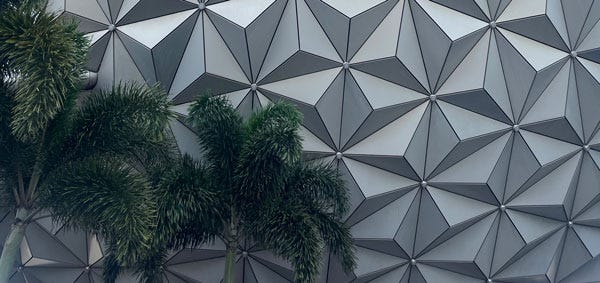
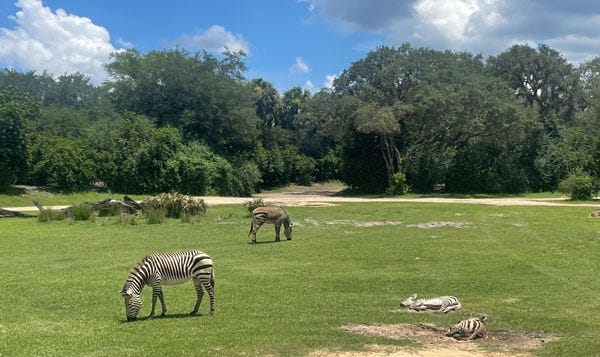
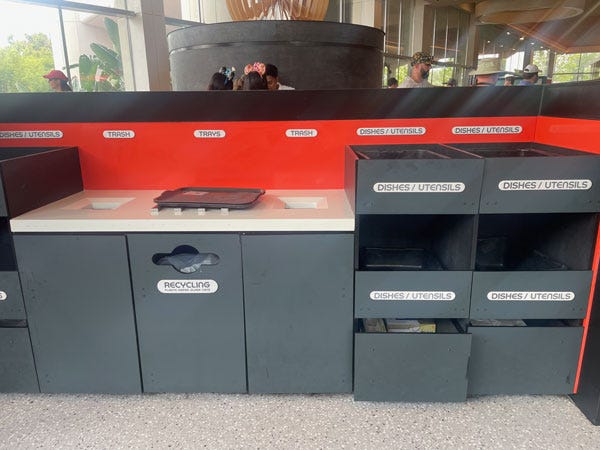

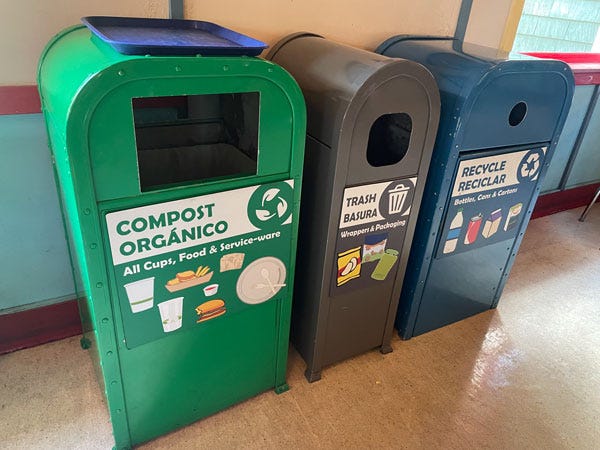
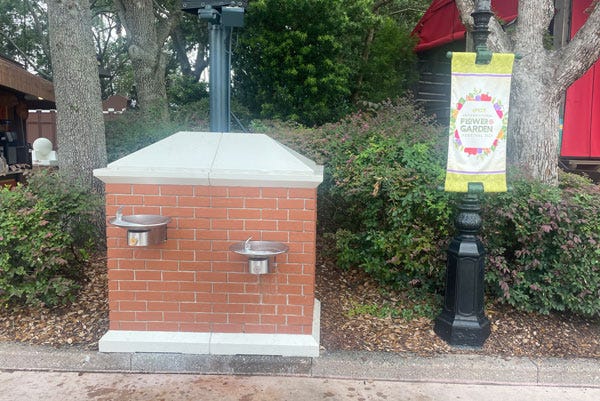
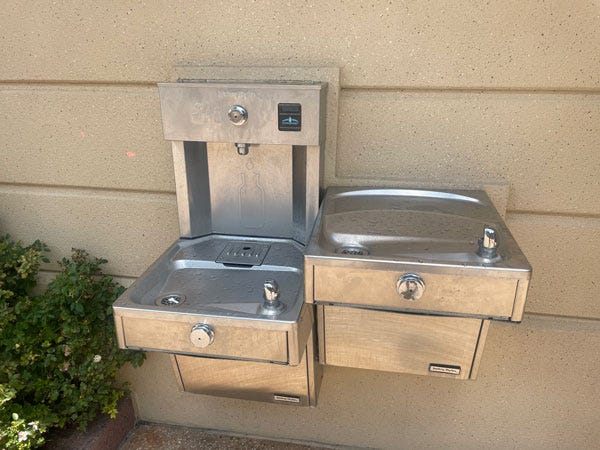
Radical idea: each person has 1-3 age-appropriate stainless steel bottle and utensils that they use during various eras of their lifetimes. They can be traded, swapped. Steel's durability means each person really only needs one set for many years. Babies, toddlers and small children upgrade to larger items, chopsticks become 1 and done, food prep workers have their special knives & other tools, adults get larger capacity bottles. Every hospitality/food/drink venue becomes refillable, with subscriptions for all you can eat/drink, or minimal commitments for those who mostly eat/drink at home. Disposable becomes as stigmatized smoking, not wearing seatbelt etc. other prior health hazards & behavioral shifts.